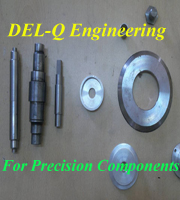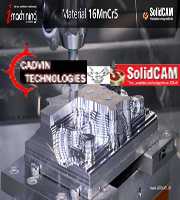I got a job in swati precision bangalore & even my batchmates got th
HIGH-SPEED METAL STAMPING
What may be considered a high-speed stamping operation at your company may not be considered high speed at other companies or in other industries. In the electronics, fastener and lamination industries, 500 to 1200 strokes/min. (SPM) are not uncommon. High-speed progressive dies for automotive or general-purpose stampings may run at 50 to 120 SPM, and high-speed transfer dies producing large, complex deep-drawn automotive parts may run at 15 to 40 SPM.
Although it can be difficult to find agreement based on strokes-per-minute, we can generally agree that high-speed stamping operations will require special attention. For example, forming and cutting more quickly requires greater stress and increased forces that can pose significant challenges for progressive and transfer tooling. These challenges include stock feeding and scrap removal, excessive tool defections, damaging tipping-moments and increased snapthrough forces that can shock and break stamping tools and damage press equipment.
The Effects of Higher Speed
As the upper die half increases in velocity, its kinetic energy also increases. Recalling some high-school physics, we know kinetic energy can be expressed as:
KE = (mv2)/2
Where:
KE = kinetic energy
m = mass
v2 = velocity squared
This makes it clear that the kinetic energy of an object can be influenced by its mass and speed. For example, a car traveling at 20 miles/hr. will deliver a greater force and do more damage as it hits some solid object than a bicycle moving at the same speed.
A car traveling at 40 miles/hr. has four times the kinetic energy as it does when traveling at 20 miles/hr., since the velocity term in the equation contains an exponent (velocity squared).
Now let’s apply this principle to a high-speed stamping die. Kinetic energy increases linearly with mass. So, when mass (the upper die weight) is doubled, kinetic energy also doubles.
Now assume that the upper die weight remains constant and we run the stamping process twice as fast as the previous production run. The mechanical press is identical except that the slide velocity will be twice as great as the previous run. Here, kinetic energy increases proportionally with the square of its speed. When speed doubles, kinetic energy increases by a factor of four. If speed were tripled, kinetic energy would increase by a factor of nine.
Some of the kinetic energy will be transferred and expended in the form of mechanical energy to deform the workpiece into the actual stamping. However, much of this energy (approximately 95 percent) will transform into less-desirable forms, such as heat, dynamic deflections and damaging vibrations.
Clearly, kinetic energy and impact vibrations associated with high-speed stamping operations must be understood and controlled in order to prevent detrimental damage to the stamping tools and press equipment.
Preventing Damage
After a mechanical press slide reaches peak velocity—at approximately 90 deg. of crankshaft rotation—the slide begins to decelerate until it eventually reaches zero velocity at bottom dead center. The slide immediately accelerates again in the opposite direction on the upstroke. Because the ram motion generates inertia—the greater the press speed the greater the inertial forces—the ram wants to continue its downward travel as the press crank tries to accelerate it in the opposite direction on the upstroke. These inertial forces place tremendous stress on press components, especially the pitman connections. Depending on the magnitude of inertia forces and the rigidity of the machine design, the pitman will elongate, effectively reducing shut height. The shut-height reduction causes die damage and introduces additional press stresses, such as impacting the large end of the pitman on the crank journal and introducing additional frame deflections.
Slug breaking in high-speed punching operations generates higher snapthrough forces, transferring additional kinetic impact energy into the frame structure in the form of vibrations. As press speeds increase, there is less time to dissipate these vibrations and they eventually can reach critical levels where magnified stresses are produced. These stresses can create a range of nuisance problems, from loosening of nuts and bolts to catastrophic problems such as a broken crankshaft or tie rods.
To reduce these occurrences, metalformers can stagger punch length to minimize impact and snapthrough shock. Splitting punch groupings into two or three different lengths can reduce impact and snapthrough shock by 30 to 50 percent. A common practice is to stagger different groups of punches by an amount equal to the stock thickness of the workpiece. Although this will reduce initial shock, it will not reduce total shock. Each group of punches is still exposed to the entire impact and snapthrough shock.
A better solution: stagger the punch lengths equivalent to the shear-band width in the hole being punched, typically less than one-third of stock thickness. This reduces impact and snapthrough shock. Staggering punches in this manner allows the next group of punches to contact the workpiece material prior to the first group snapping through. The snapthrough energy from the first group of punches is absorbed and used to drive the next set of punches through the material.
Punching holes in high-speed applications also requires special attention to tool-steel selection. High-speed punching operations generate a significant amount of frictional heat, while also minimizing (by the same factor) the amount of contact time the tooling has with the workpiece. This reduces the opportunity for the punch to dissipate heat into the work material, which affords some additional cooling.
Because small punches have much less ability to dissipate heat, they are more prone to overheat. This can result in reduced hardness, wear resistance and dimensional stability. High-speed or powder-metal tool steels such as M4 and PM-10V are tempered at temperatures above 1000 F, giving them temper resistance superior to A2 and D2 in high-speed applications.
Like us on Facebook for latest updates on Jobs, Companies and upcoming News & Events




















